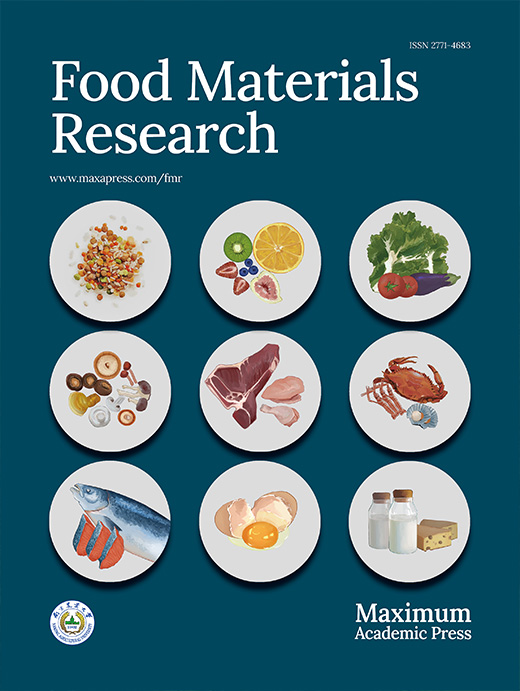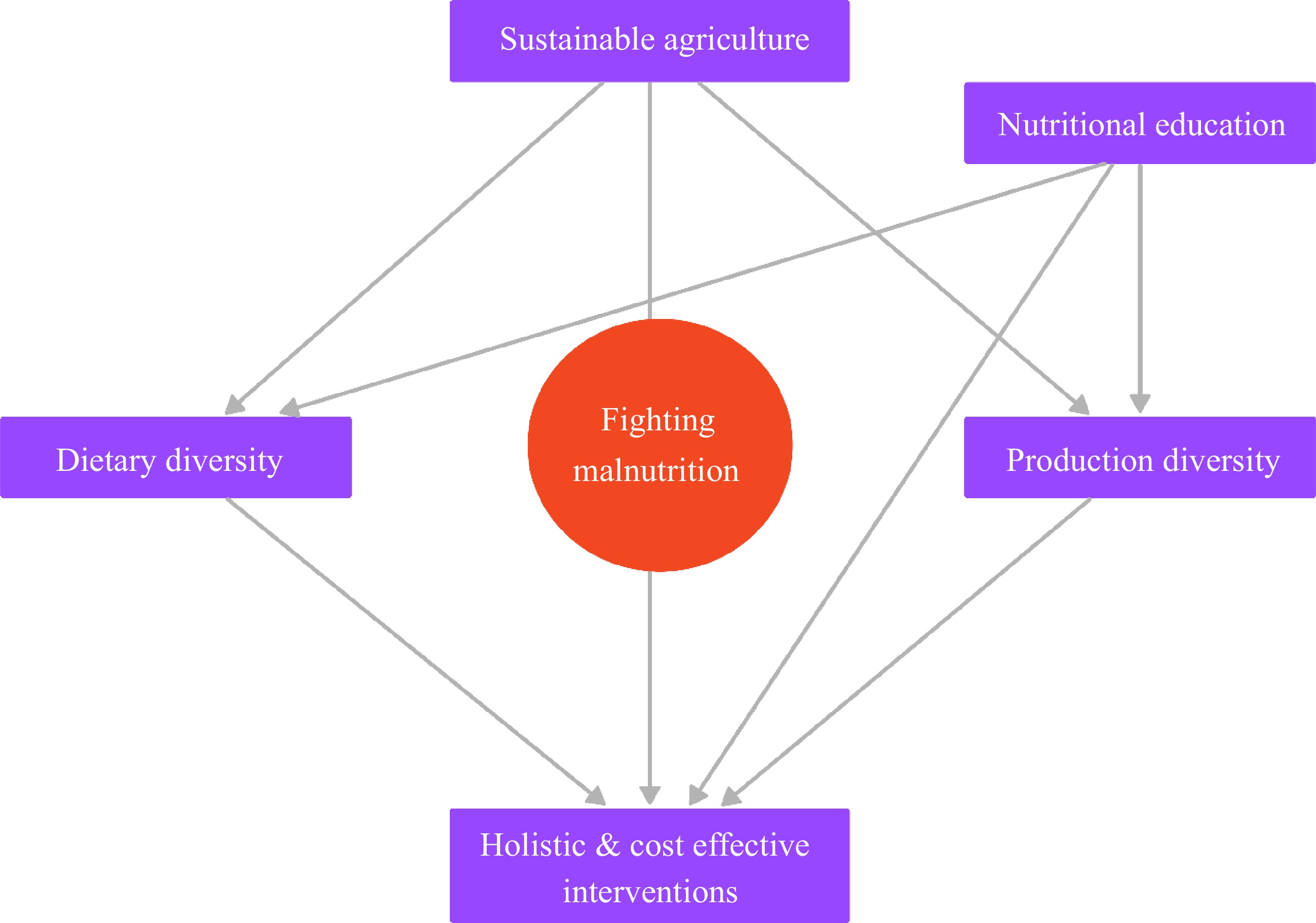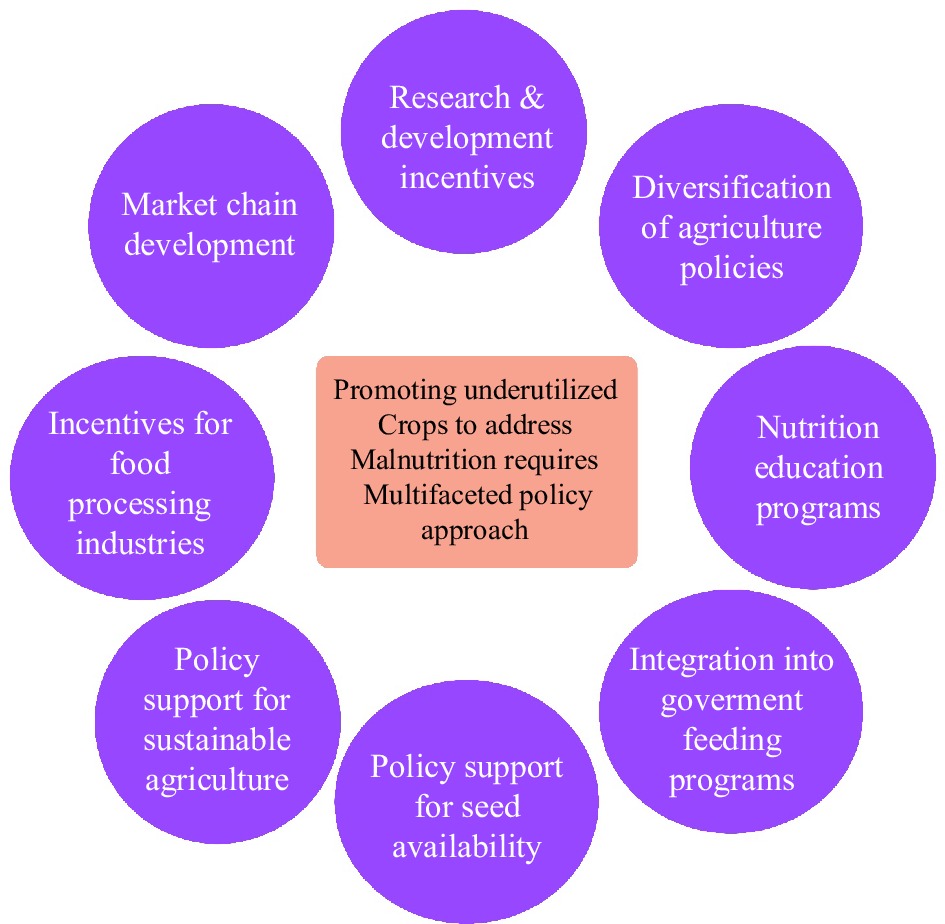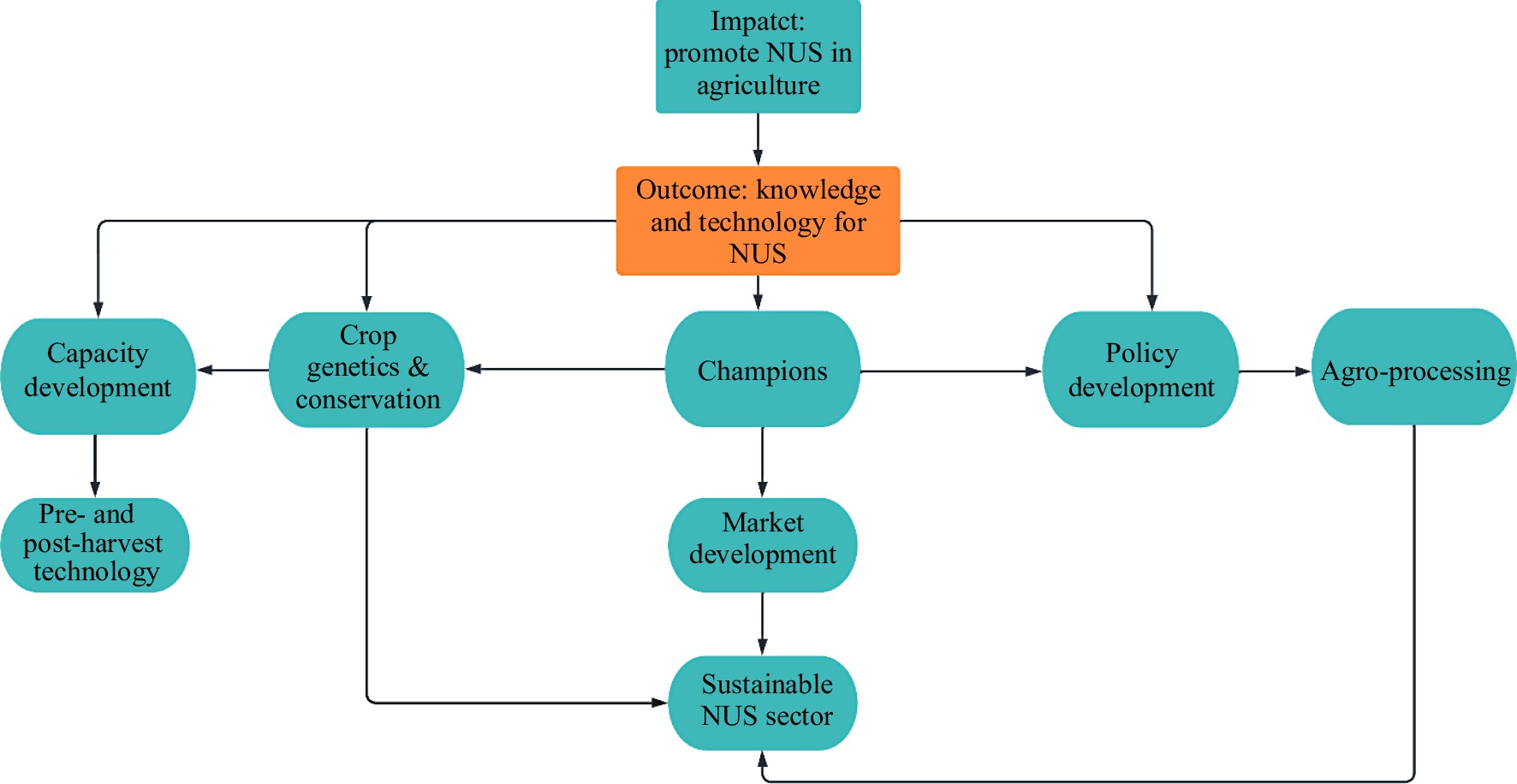-
Underutilized crops, also known as neglected and underutilized species (NUS) crops, are an array of diverse plant species that have not been fully integrated into mainstream agriculture despite their significance in local communities, especially in regions rich in agrobiodiversity. These crops, including cereals, fruits, nuts, vegetables, pulses, and legumes, offer unique benefits to local diets and agricultural practices, providing specific health benefits beyond essential nutrition.
Cereals and pseudocereals, such as Amaranthus caudatus and Chenopodium quinoa, are particularly noteworthy for their adaptability to marginal conditions and vital role in local food systems. These crops are not only nutritionally rich but also culturally and economically significant. Fruits and nuts, exemplified by species like Ziziphus mauritiana and Adansonia digitata, deliver nutritional value and cultural and economic benefits. Vegetables and pulses, including species like Ipomoea aquatica, are crucial for their high nutritional content and environmental resilience. The legume category, featuring crops such as African yam bean (Sphenostylis stenocarpa) and pigeon pea (Cajanus cajan), is renowned for its high protein content, playing a pivotal role in the diets of many globally[1].
These crops have been recognized increasingly for addressing food and nutrition security concerns, especially in regions facing climate change and limited agricultural resources[2]. They are part of rational nutrition and therapeutic diets, and are recognized as functional foods due to specific qualitative properties and potential health benefits, such as reducing the risk of heart disease and diabetes[3]. With specific nutritional properties, underutilized crops like buckwheat and finger millet contribute to nutrition diversification, the ability to withstand drought stress, economic importance, and food production[4].
However, these crops often face challenges in production, such as limited germplasm, scant technical information, and a lack of supportive policies. Despite such challenges, underutilized crops offer numerous advantages, including enhanced nutritional quality and safety, increased income from fruits and vegetables, and sustainable income from forests and trees[5]. They are vital for developing resilient food systems and addressing global food security challenges. Research has shown that neglected botanicals, such as millet, sorghum, and sesame, can affect overall productivity of underutilized food crops. These botanicals can be used as phyto-fertilizers to enhance the growth and productivity of such crops[6]. Furthermore, underutilized field crops can increase functional biodiversity, essential for diverse nutritional and health products[7]. Introducing underutilized crops into small-scale farms can have beneficial social and economic effects.
Underutilized crops like teff have become increasingly significant in global health and diet trends, such as gluten-free and 'superfood' diets[8]. Their high antioxidant activity makes them valuable for health-promoting properties[9]. Functional beverages containing underutilized crops have been encouraged as they increase the economic value of the crops and provide health benefits to consumers[10].
-
Functional foods derived from underutilized crops offer a range of benefits for nutrition, health, and income generation. These foods are rich in essential vitamins, antioxidants, and other bioactive compounds contributing to overall well-being[11]. For example, quinoa, and barley grains have been found to contain high levels of vitamins and antioxidants, making them valuable ingredients for functional food formulations[11]. The consumption of functional foods can help address nutritional deficiencies and promote a balanced diet, particularly in regions where access to diverse and nutritious food sources is limited[12].
Functional foods from underused crops provide economic and environmental benefits beyond just nutrition. By promoting the cultivation and utilization of underutilized crops, farmers can diversify their income sources and reduce their dependence on a limited number of major crops[5]. Such diversification can enhance agricultural systems' resilience and contribute to agrobiodiversity conservation[13]. Furthermore, producing functional foods can create value addition and agro-processing opportunities, leading to the development and generation of employment in small-scale industries[14].
Health benefits
-
Figure 1 illustrates a multifaceted strategy to combat malnutrition, emphasizing the interconnected roles of sustainable agriculture, nutritional education, production diversity, and holistic, cost-effective interventions to promote dietary diversity. The health benefits of consuming such crops are described in Table 1 and are outlined in the following paragraphs.
Combating malnutrition
-
The utilization of underutilized crops as a means to combat malnutrition presents an innovative and sustainable approach with potentially far-reaching implications[15]. Underutilized crops offer a promising avenue for diversifying diets and addressing nutrient deficiencies[7]. These crops, characterized by their unique nutrient profiles, can fill critical gaps in dietary intake, offering a more comprehensive range of essential vitamins, minerals, and antioxidants[16]. Such diverse nutritional spectrum is pivotal in combating malnutrition, from micronutrient deficiencies to protein-energy malnutrition[16,17]. Moreover, underutilized crops can be meticulously selected to target specific nutritional gaps within populations. Crops such as amaranth and moringa, rich in iron, calcium, and vitamin A, can be effectively deployed to combat anaemia and vitamin A deficiency in high-risk regions. The precise targeting optimizes the efficiency and efficacy of malnutrition mitigation efforts, connecting the dots between crop selection and nutritional needs[14]. Their remarkable adaptability to varying environmental conditions makes underutilized crops even more compelling. These crops tend to be resilient, requiring fewer agricultural inputs and demonstrating robust growth in challenging climates. Their versatility empowers vulnerable communities by enhancing food security and nutritional intake with locally grown, sustainable crops. The connection between crop adaptability and local empowerment bridges the gap between climate resilience and nutritional security[15]. In an era of climate change, these crops are proving their worth as resilient assets in the quest for food security. Many underutilized crops have demonstrated their ability to thrive amidst changing weather patterns, even in adverse climate conditions[15]. Their reliability in providing a stable food supply is instrumental in the battle against malnutrition. The link between climate-resilient crops and food security is essential for connecting the environmental and nutritional dots.
Table 1. Health benefits of consuming underutilized crops.
Name Scientific name Property Nutrient composition Health benefits Ref. African yam bean Sphenostylis stenocarpa Legume High in protein, fiber, and antioxidants Improves blood sugar control, boost immunity, and reduce inflammation [18] Amaranth Amaranthus spp. Gluten-free pseudocereal Rich in essential amino acids, fiber, and micronutrients High levels of squalene, which may have antioxidant and anti-inflammatory properties [19] Amur Cork Tree Phellodendron amurense Seeds from the amur cork tree Contains silymarin and antioxidants Potential liver-protective effects, may aid in digestion, and offer antioxidant properties [20] Bambara Groundnut Vigna subterranea Legume High in protein, fiber, and iron Improves blood sugar control, reduce cholesterol levels, and promote weight loss [21] Bamboo Rice Oryza rufipogon Rice variety derived from bamboo seeds High in dietary fiber, vitamins, and minerals Support digestion, provide energy, and offer essential nutrients [22] Bamboo Shoots Oryza rufipogon Edible shoots of bamboo plants Low in calories, high in dietary fiber Good source of vitamins, minerals, and antioxidants [23] Baobab Adansonia digitata Fruit pulp from the baobab tree High in vitamin C, fiber, and antioxidants Immune-boosting and anti-inflammatory properties [24] Black Currants Ribes nigrum Berries from the black currant shrub High in vitamin C, anthocyanins, and antioxidants Strong antioxidant properties, may support immune function and cardiovascular health [25] Buckwheat Fagopyrum esculentum Gluten-free pseudocereal Contains rutin (a flavonoid), fiber, and protein Potential cardiovascular benefits due to rutin content [26] Camelina Camelina sativa Oil from camelina plant seeds Rich in omega-3 fatty acids Potential cardiovascular benefits [27] Camu Camu Myrciaria dubia Fruit from the camu camu tree Exceptionally high in vitamin C Immune-boosting, potential anti-inflammatory effects, and skin health benefits [28] Celeriac Apium graveolens var. rapaceum Root vegetable Good source of fiber, vitamins, and minerals Supports digestive health, provides antioxidants, and may help regulate blood pressure [29] Chayote Sechium edule Green, wrinkled fruit Low in calories, high in fiber and antioxidants Promotes weight loss, support heart health, and provide immune-boosting properties [30] Chia Salvia hispanica Seeds from the chia plant High in omega-3 fatty acids, fiber, and antioxidants Considered a superfood with various health benefits [31] Chokeberry Aronia melanocarpa Fruit from the chokeberry shrub High in anthocyanins, vitamins, and antioxidants Supports cardiovascular health, may have anti-inflammatory properties, and offer immune-boosting benefits [32] Cloudberry Rubus chamaemorus Berry from the cloudberry plant High in vitamin C, fiber, and antioxidants Supports immune function, skin health, and may have potential anti-inflammatory properties [33] Cowpea Vigna unguiculata Legume High in protein, fiber, and folate Improves blood sugar control, boost immunity, and promote healthy pregnancy [34] Elderberries Sambucus nigra Berries from the elderberry shrub High in anthocyanins, vitamins, and fiber Immune-boosting, potential antiviral properties, and relief from cold and flu symptoms [35] Fonio Digitaria exilis Small-grained cereal Good protein and fiber content Nutrient-rich and gaining recognition for its nutritional value [36] Ground Cherries Physalis peruviana Fruit from the ground cherry plant Good source of vitamin C, fiber, and beta-carotene Immune-boosting, potential anti-inflammatory properties, and improved eye health [37] Jerusalem Artichoke Helianthus tuberosus Tuber of the Jerusalem artichoke plant Contains inulin, a prebiotic fiber Promotes gut health and improved digestion [38] Jicama Pachyrhizus erosus Root vegetable Low in calories, high in fiber and vitamin C Supports digestion, promote weight loss, and provide immune-boosting benefits [39] Lacinato Kale Brassica oleracea var. sabellica Type of kale Rich in vitamins A, C, and K, and fiber Supports eye health, bone health, and digestion [40] Lotus Root Nelumbo nucifera Rhizome of the lotus plant Rich in dietary fiber, vitamins, and minerals May support digestion and overall health [41] Mesquite Genera Prosopis Leguminous tree or shrub High in protein, fiber, and minerals May help regulate blood sugar, support digestion, and have antioxidant properties [42] Millet Varied, e.g., Panicum miliaceum Pseudocereal High in fibre, magnesium, and iron Improves blood sugar control, reduce cholesterol levels, and improve digestion [43] Moringa Moringa oleifera Leaves and pods of the moringa tree Rich source of vitamins, minerals, and antioxidants Anti-inflammatory, anti-diabetic, and overall health-promoting properties [44] Nance Fruit Byrsonima crassifolia Fruit from the nance tree High in vitamin C, fiber, and antioxidants Immune-boosting, potential anti-inflammatory properties, and digestive health benefits [45] Nopal Cactus Opuntia spp. Pads of the prickly pear cactus Rich in fiber, vitamins, and minerals Aid in weight management, support blood sugar control, and promote heart health [46] Perilla Seeds Perilla frutescens Seeds from the perilla plant Rich in omega-3 fatty acids, fiber, and antioxidants Support heart health, reduce inflammation, and offer potential benefits for allergies and asthma [47] Purple Carrots Daucus carota Variety of carrots with purple flesh High in anthocyanins, vitamins, and fiber Antioxidant properties, supports eye health, and may have anti-inflammatory effects [48] Quinoa Chenopodium quinoa Whole grain, complete protein source Rich in essential amino acids, vitamins, and minerals Gluten-free and with antioxidant properties [49] Red Clover Trifolium pratense Legume plant Rich in isoflavones, vitamins, and minerals Supports hormonal balance, may relieve menopausal symptoms, and offer antioxidant properties [50] Red Spinach Amaranthus dubius Variety of spinach Rich in vitamins A, C, and K, and antioxidants Supports eye health, bone health, and offers potential anti-inflammatory benefits [51,52] Sea Buckthorn Hippophae rhamnoides Berries from the sea buckthorn shrub Rich in vitamins, omega fatty acids, and antioxidants Supports skin health, may improve heart health, and have immune-boosting properties [53] Sea Vegetables Varied, e.g., Saccharina japonica Edible seaweeds Rich in vitamins, minerals, and iodine Supports thyroid health, may have detoxifying properties, and provide essential nutrients [54] Sorghum Sorghum bicolor Whole grain, gluten-free Rich in antioxidants, low glycemic index Good option for individuals with diabetes and source of antioxidants [55] Soursop Annona muricata Fruit from the soursop tree Contains vitamins, minerals, and bioactive compounds May have potential anticancer and anti-inflammatory properties [56] Teff Eragrostis tef Gluten-free whole grain High in fiber and protein, source of iron and calcium Suitable for those with dietary restrictions and potentially beneficial for health [57] Tiger Nuts Cyperus esculentus Tubers from the tiger nut sedge Rich in fiber, healthy fats, and minerals May support digestion, provide energy, and have potential prebiotic effects [58] Watercress Nasturtium officinale Leafy green vegetable Excellent source of vitamin K, C, and antioxidants Supports bone health, may reduce cancer risk, and promotes skin health [59] Winged Beans Psophocarpus tetragonolobus Leguminous plant Rich in protein, fiber, and vitamins Good source of essential nutrients, supports digestion, and may help regulate blood sugar [60] Yacon Smallanthus sonchifolius Tuber of the yacon plant Contains fructooligosaccharides (FOS) and antioxidants Supports gut health, may aid in weight management, and improve blood sugar control [61] Furthermore, the cultivation and integration of underutilized crops can lead to community engagement and empowerment[14]. Such crops bolster access to diverse and nutritious foods and reduce dependence on external food aid[14]. By involving local communities in producing such crops, we foster a sense of ownership over their nutritional well-being, strengthening the connection between food security and community self-sufficiency. A comprehensive strategy is required to scale up the application of underutilized crops for malnutrition mitigation. Addressing challenges, such as limited awareness and market access, is crucial[15]. Public awareness campaigns, capacity-building initiatives, research and development investments, and supportive policy reforms are necessary to bridge the gap between underutilized crops and broader adoption. By strategically connecting these dots and addressing the challenges and barriers to their adoption, we can harness the nutritional benefits of underutilized crops and make substantial progress toward a malnutrition-free future[15].
Disease prevention
-
Functional foods, rich in biologically active compounds, are crucial in preventing and managing chronic diseases like cardiovascular diseases, high cholesterol, and diabetes. Such foods, often called nutraceuticals, enhance the economic value of underutilized crops while providing significant health benefits. Including such crops in diets addresses global nutritional needs and contributes to the diversification of diets, thereby enhancing overall health. Studies have demonstrated that functional foods can target significant risk factors for chronic diseases, such as hypertension and dyslipidemias, thereby reducing the incidence of such conditions[62,63].
Regarding enhancing immune function, functional foods from underutilized crops are rich in phytonutrients, vitamins, antioxidants, and bioactive compounds. These components are vital in boosting the immune system, aiding the body in fending off infections, and enhancing immunocompetence. Encapsulated food products developed from such crops have effectively boosted immunity and protect against diseases like COVID-19. The immunomodulatory potential of these bioactive compounds in fruits from underutilized crops has been acknowledged for enhancing immune function[64,65].
Furthermore, consuming these functional foods can help provide essential micronutrients and other bioactive compounds necessary for supporting a healthy immune system. This aspect is essential as deficiencies in specific micronutrients can impair immune function. Therefore, functional foods from underutilized crops offer a holistic approach to health, combining disease prevention with immune system enhancement[66,67].
Such synthesis emphasizes functional foods' dual role in preventing chronic diseases and enhancing immune function, underscoring the importance of incorporating these foods into diets for overall health and well-being. The integration of these two health sections provides a comprehensive view of the multifaceted benefits of functional foods, particularly those derived from underutilized crops.
Improved digestion
-
Functional foods from underutilized crops can improve digestion and overall health and well-being. Such underutilized crops have specific qualitative properties such as taste, nutrition, and health benefits and are recognized as functional foods[11]. They are part of rational nutrition and therapeutic diets. Incorporating these crops into the diet can improve digestion and better nutritional outcomes. These crops, often neglected or overlooked, can increase dietary diversity, improve nutritional status, and reduce household food and nutrition insecurity[68]. The nutritional properties of underutilized crops make them suitable for improving digestion. One notable example of such crops is the tuber family, particularly Dioscorea species, commonly known as yams. These crops are crucial in ensuring food security in developing regions, owing to their high energy value and carbohydrate content. Specifically, Chinese yam (Dioscorea polystachya) nourishes millions globally and brings multiple health benefits, including aiding digestion.
Recent research has shed light on the potential of plant hormones, such as brassinosteroids, to influence the tuber shape in Chinese yam, which could have implications for breeding strategies and improving crop systems[69]. Millet, widely consumed in parts of Africa and Asia, is another underutilized crop beneficial for digestion. It is appreciated for its taste and nutritional value, which includes high fibre content. Fibre is essential for healthy digestion, as it supports bowel regularity and helps maintain a healthy gut microbiome. The consumption patterns of millet in countries like Uganda and Ethiopia highlight its potential as a nutritious staple that can be integrated into more diverse diets[70].
These crops can be incorporated into the diet to enhance digestion and reduce the risk of digestive disorders. In addition to nutritional benefits, underutilized crops can also improve animal digestion. For example, improving the ruminal fibre degradability of underutilized crop residues, such as barley straw, can provide additional energy to ruminants and increase the nutritional value of these feeds[71]. Furthermore, incorporating underutilized crops into the food system can increase dietary diversity and contribute to more sustainable and resilient agro-and horti-food systems[72]. By tapping into the potential of underutilized crops, it is possible to achieve improved digestion and overall nutritional well-being.
Antioxidant properties
-
Underutilized crops, such as Raphanus sativus, Eruca sativa, and Hibiscus sabdariffa, contain phytochemicals with antioxidant activity[73]. African underutilized legumes are also known for their nutritional and functional properties, including antioxidants and bioactive compounds[74]. Similarly, underutilized wild edibles, like Coccinia grandis, possess antioxidants and phytochemicals[75]. Certain underutilized crops, including quinoa, and barley contain vitamins and antioxidants, such as tocopherols and tocotrienols[11]. Aronia berries, an underutilized functional food, are rich in bioactives, including antioxidants[76]. Other underutilized crops, such as liposu and tampoi fruits, have been found to contain phenolic compounds and exhibit antioxidant properties[77]. The antioxidant properties of underutilized crops make them valuable for the development of functional foods. These crops can be used as alternative sources of bioactive compounds and nutraceuticals in the food industry[78]. Wild fruits' bioactivities and health benefits, including their antioxidant, antimicrobial, anti-inflammatory, and anticancer activities, highlight their potential as functional foods[79].
Weight management
-
Weight management is essential to overall health and well-being[11]. High-fiber and low-calorie, underutilized crops can assist in weight management and obesity prevention. Underutilized crops with specific qualitative properties such as taste, nutrition, and health benefits are considered functional foods and can contribute to weight management and overall health[11]. Although the overdependence on major crops like wheat, maize, and rice has led to shortages and the need for alternative food sources[80], the conservation, improvement, and utilization of underutilized plant species, such as African eggplant, are crucial in addressing these challenges[80].
Benefit to farmers
-
Underappreciated and lesser-known crops offer various transformative benefits for agricultural communities, ecosystems, and global sustainability (Table 2). The underutilized crops possess intrinsic attributes that bolster resilience, engender economic opportunities, mitigate climate change impacts, and foster a paradigm shift toward sustainable agriculture. Underutilized crops, endowed with inherent adaptations to specific local conditions, emerge as sentinels of improved resilience against environmental stressors[81]. They exhibit remarkable tenacity in facing challenges like drought, salinity, and extreme temperatures[81]. Harnessing their unique genetic traits becomes a potent strategy to fortify agriculture against the growing threat of climate change.
Table 2. Analysis of benefits to farmers from cultivation of underutilized crop species.
Benefit Description Ref. Enhanced biodiversity Promotes agricultural diversity, preserving unique genetic resources [87] Nutritional diversity Offers a rich source of diverse nutrients for a balanced diet [70] Resilience to climate change Better adaptation to adverse weather, pests, and diseases [88] Economic opportunities Access to niche markets, potentially higher prices for specialty crops [89] Soil health improvement Balances soil nutrient levels, breaking up soil compaction, suppressing weeds, fixing nitrogen, and improving soil tilth [90] Cultural significance Preserves traditional farming practices and local heritage [91] Reduced input costs Lower requirements for fertilizers and pesticides [92,93] Sustainability Contributes to sustainable farming systems and ecological balance [94] Risk diversification Reduces economic risk by not relying on a single crop type [95] Market demand for novelty Meets consumer demand for new and unique food products [96] Water efficiency Some underutilized crops require less water, beneficial in areas with water scarcity [97] Pest and disease resistance Natural resistance to certain pests and diseases, reducing the need for pest control measures [98,99] Adaptability to marginal lands Suitable for growth in less fertile or challenging terrains, utilizing otherwise unproductive land [100] Local food security Contributes to local and regional food security by offering alternative food sources [101] Empowerment of smallholders Small-scale farmers can benefit from growing unique crops that are not viable for large-scale commercial farming [102,103] Improved community engagement Cultivating traditional or local crops can strengthen community ties and knowledge sharing [104,105] Agro-tourism potential Unique crops can attract tourists, offering additional income through farm visits and local markets [106] Heritage conservation Helps in preserving heirloom varieties and traditional farming methods, enriching cultural heritage [107] Alternative income sources Opportunities to sell crop by-products or engage in value-added processing [89] Learning and Innovation Encourages farmers to learn new agricultural techniques and innovate in crop management [108] Moreover, these uncharted agricultural resources unfurl new horizons of economic opportunities. They provide local and small-scale farmers with the key to unlocking novel markets and revenue streams[12]. Simultaneously, underutilized crops cater to specialized needs, offering niche products that satiate the discerning consumer's palate. The diversification of agricultural production ensures long-term economic stability, uplifting farming communities[12].
In a world besieged by climate change, the exceptional tolerance of some underutilized crops to their impacts bears vital significance[82]. Such resilient crops form a cornerstone in adapting to shifting environmental conditions. As climate volatility escalates, their role in securing food systems and preserving livelihoods cannot be overstated. The diminished pest and disease pressure encountered by underutilized crops distinguishes them from their mainstream counterparts[83]. Less commonly grown, these crops evade the widespread infestations plaguing conventionally cultivated varieties.
Consequently, they demand fewer inputs such as pesticides and fertilizers, resulting in lower production costs and fostering ecological balance. In sustainable agriculture, underutilized crops align seamlessly with principles that promote biodiversity, soil health, and resource conservation[84]. Their cultivation bolsters ecosystems and enhances soil fertility. Some of these crops possess deep root systems that facilitate improved soil structure, nutrient cycling, and fertility, setting a precedent for regenerative agricultural practices.
Furthermore, the adoption of underutilized crops is a catalyst for income diversification[85]. Farmers can create additional revenue streams by growing these crops, effectively reducing their economic vulnerability. The financial resilience equips them to withstand economic fluctuations, offering a lifeline for communities dependent on agriculture.
Incorporating underutilized crops into mainstream agricultural practices is an imperative shift towards sustainable, climate-resilient, and economically robust systems[7]. Their intrinsic attributes, including enhanced resilience, economic opportunities, climate adaptation, reduced pest pressure, lower input costs, and income diversification, render them indispensable in pursuing global food security and environmental sustainability[86].
Other benefits
-
In an era marked by the increasing demands of a growing global population and the mounting challenges posed by climate change and environmental degradation, cultivating underutilized crops has emerged as a multifaceted strategy to address numerous critical issues in agriculture and food security[12]. Underutilized crops offer manifold advantages that extend far beyond their apparent obscurity. By exploring these lesser-known agricultural resources, we can actively contribute to biodiversity conservation, reduce pressure on major crops, enhance nutritional diversity, preserve cultural heritage, and promote sustainable land management, among other significant benefits[7,12,97,109]. Biodiversity conservation stands at the forefront of the advantages associated with underutilized crops. These unheralded plant species possess unique genetic traits that can help preserve and protect genetic diversity in agriculture[7]. By cultivating underutilized crops, we take a proactive stance against the loss of rare and distinct plant varieties, safeguarding our agricultural heritage[7,12,110]. One of the immediate benefits of diversifying agricultural production with underutilized crops is the reduced pressure on major crops. The overreliance on a few staple crops leaves our food systems vulnerable to crop diseases, pests, and changing environmental conditions[12]. Underutilized crops act as an agricultural insurance policy, mitigating risks by diversifying the production landscape[12,97,111].
Moreover, the nutritional diversity underutilized crops offer is a remarkable asset in promoting public health. Many crops have essential vitamins, minerals, and other beneficial compounds. Incorporating them into our diets enhances our nutritional intake and fosters a more balanced and diverse culinary experience[109]. Cultural heritage preservation is another dimension of underutilized crop cultivation. Growing such crops protects traditional and indigenous agricultural practices and food cultures. The continuity of these practices is integral to maintaining the heritage of various communities and fostering cultural resilience[7,12,112]. In addition to their intrinsic value in agriculture and nutrition, underutilized crops contribute to ecosystem services. They aid in soil improvement, pest control, and pollinator support, benefiting agricultural sustainability and ecosystem health[7]. Diversifying crop cultivation with underutilized crops conserves biodiversity and lessens the pressure on land and resources. Such actions promote sustainable land management and reduce the demand for land, water, and other essential resources, helping us tread the path of agricultural sustainability[12,97,113]. Furthermore, underutilized crops are pivotal in ensuring food security, particularly in regions prone to crop failures and food shortages. They serve as a vital food source during times of crisis, helping to bridge the gap in food availability and alleviating hunger[12,97].
Many underutilized crops, whose potential remains untapped, exhibit medicinal properties and offer a rich reservoir of herbal remedies and pharmaceutical compounds. Their exploitation in the healthcare sector presents exciting opportunities for research and innovation[109]. From a market perspective, some underutilized crops cater to niche and speciality markets, offering unique flavours, textures, and culinary experiences for discerning consumers. This diversity enriches local cuisines and contributes to the broader tapestry of gastronomic traditions[12,114]. Cultivating underutilized crops introduces new flavours and ingredients into local cuisines, contributing to cultural and culinary diversity. This enriching effect transcends the boundaries of food and promotes cross-cultural exchange and appreciation[12,114].
Overall, cultivating underutilized crops is indispensable in addressing the multifaceted challenges facing agriculture and food security. By actively embracing these lesser-known resources, we can protect biodiversity, ensure food security, and foster nutritional, cultural, and ecological diversity, among many other benefits[7,12,113]. As we embark on this journey, it becomes evident that underutilized crops offer a holistic and sustainable solution to the complex issues confronting our global food system. Furthermore, they provide valuable agricultural research, education, and capacity-building opportunities in farming communities, reinforcing pivotal role in shaping the future of agriculture and sustainable development[7,12,113].
-
Microbiological innovations play a crucial role in developing functional foods from underutilized crops. Fermentation, for example, is a widely used technique that harnesses the metabolic activities of microorganisms to transform raw materials into products with improved nutritional and sensory properties[115]. Fermented foods have been in use for thousands of years, and are recognized for various health advantages, including enhanced digestive function, increased absorption of nutrients, and the generation of bioactive compounds[116]. The microbial composition of fermented foods is diverse and can vary depending on the raw materials, fermentation process, and environmental conditions[117]. Understanding the microbial dynamics in fermented foods is essential for optimizing their functional properties and ensuring food safety[118].
In addition to fermentation, other microbiological approaches can enhance the nutritional value and safety of functional foods from underutilized crops. For example, using modified atmosphere packaging (MAP) technology can extend the shelf life of fresh or fresh-cut produce, reducing spoilage and microbial contamination[119]. MAP involves modifying the gaseous environment surrounding the food product, creating conditions that inhibit the growth of spoilage microorganisms and pathogens[119]. This technology has been successfully applied to various underutilized crops, ensuring their availability and quality for extended periods.
The MAP technology has become a key player in meeting consumer demands for fresh, refrigerated foods with extended shelf life. The critical aspect of MAP is its impact on the microbiological safety of food products. This technology typically employs atmospheres with high carbon dioxide levels to inhibit aerobic spoilage organisms. However, this process can lead to the growth or stimulation of certain pathogens, such as Listeria monocytogenes, Aeromonas hydrophila, and Yersinia enterocolitica, especially in foods with extended shelf life. The safety concerns in MAP foods are highlighted by the potential growth of Clostridium botulinum in food products and the enhanced survival of anaerobic spores and Campylobacter jejuni under certain gas atmospheres[120].
Furthermore, selecting specific microbial strains with desirable characteristics can improve the functional properties of fermented foods and beverages. Autochthonous microbial strains, indigenous to a particular region or ecosystem, have been found to possess unique metabolic capabilities and can contribute to the development of functional foods with specific health benefits. These strains can be selected through deliberate screening and isolation processes, considering their ability to produce bioactive compounds, enhance nutrient bioavailability, and improve sensory attributes[115].
Complementing this approach is the realm of food fermentation, a time-honoured method that has been revolutionized by microbial technology. The development of starter cultures marks a significant advancement in this field. Studies have explored the role of yeasts, like Wickerhamomyces anomalus Y-1, in flavor and aroma enhancement during Chinese liquor fermentation. Similarly, research into the dynamic changes in Daqu, a Chinese liquor fermentation starter, provides insight into factors influencing microbial communities and physicochemical properties during fermentation. Fermented dairy products, like kefir yogurt and stirred yogurt, are being explored for their potential to deliver synbiotic compounds, thereby contributing to safe, tasty, and nutritious foods[121].
The sustainable production of food ingredients using synthetic biology represents another leap forward. Organisms are reprogrammed to function as engineered cell factories by designing and constructing novel biomolecular components. This approach has been employed to increase the production of isomaltulose using an engineered strain of Corynebacterium glutamicum. Advances have also been made in producing rare sugars like D-allulose, which have potential health benefits. These innovations in microbial engineering are broadening the range of available feedstocks, leading to more sustainable and high-quality food production[121].
Moreover, the innovations related to the gut microbiome have opened new avenues in functional foods, dietary supplements, and therapeutic applications. For instance, gut microbiota transplantation from diet-tolerant animals to rats has shown promise in reducing serum lipid levels and hepatic lipid accumulation, indicating potential therapeutic strategies for metabolic disorders. Exploring the gastric juice microbiota in chronic gastritis patients has suggested new therapeutic targets. Such ongoing research in the microbiome field creates opportunities for bioeconomy approaches, providing practical solutions with potential for commercial application and enhancing social well-being.
-
Policy interventions are crucial in promoting underutilized crops and addressing the challenges associated with their cultivation, utilization, and commercialization. These interventions aim to improve the status of underutilized crops by identifying and evaluating their underutilization and implementing appropriate interventions at international, national, and local levels[103]. Such interventions focus on shifting policies towards favouring underutilized crops instead of the dominant staple crops such as maize, rice, and wheat[122]. Policy interventions promoting underutilized crops can contribute to climate-smart agriculture, food security, nutrition, and health.
One of the challenges in promoting underutilized crops is the underutilization of social insurance among the poor, which can hinder the adoption and utilization of these crops[123]. Interventions that improve benefit awareness and address the barriers to accessing social insurance can help combat the problem of underutilization[123]. Additionally, policy interventions should prioritize the development of underutilized crops by formulating and prioritizing governing policies based on the analysis of production and trade trends[124]. This approach can help ensure the policies are tailored to the specific needs and potential of underutilized crops in different regions.
Underutilized crops are recognized for their potential to meet the world's demand for food, and their importance has been acknowledged by research communities, governments, and policymakers worldwide[125]. These crops although have high nutritional value and can contribute to sustainable nutrition security[14]. However, their role in achieving nutrition security is not adequately understood, and they are often overlooked in food and nutrition policies and programs. Therefore, policy interventions should focus on tapping into the potential of neglected and underutilized food crops to ensure sustainable nutrition security[14].
Policy interventions should consider the factors influencing farmers' decisions to adopt innovations in underutilized crops to promote underutilized crops effectively[126]. Understanding these factors can help design targeted interventions that address farmers' needs and challenges in adopting underutilized crops. Additionally, policy interventions should address the limited availability of germplasm and the lack of molecular marker systems for assessing the diversity of underutilized crops[127]. These challenges can hinder the successful improvement and promotion of underutilized crops and should be addressed through policy interventions (Fig. 2).
Participatory breeding and the involvement of small-scale farmers are essential strategies for promoting the conservation and sustainable use of underutilized crops[103]. Such crops tend to harbor high levels of genetic diversity and are maintained on-farm in small-scale farming systems[103]. However, they are relatively neglected by formal research and development strategies, including breeding programs. Policy interventions should prioritize the involvement of small-scale farmers in conserving and breeding underutilized crops to ensure their long-term sustainability (Fig. 3).
-
The article underscores the importance of underutilized crop superfoods as transformative agents for human health, agricultural sustainability, and global food security. The intricate exploration of the health benefits of such crops, encompassing disease prevention, enhanced digestion, potent antioxidant properties, reinforced immune function, combatting malnutrition, and facilitating weight management, illuminates their potential to address pressing health challenges. Simultaneously, it is evident that these superfoods offer a lifeline to farmers, enabling diversification, enhanced livelihoods, and the promotion of ecologically sound agricultural practices. Beyond individual health and agrarian economies, the multifaceted benefits extend to environmental preservation, biodiversity conservation, and the mitigation of impending food crises.
A thorough exploration of certain underutilized crop superfoods, such as amaranth, quinoa, and moringa, highlights their exceptional nutritional compositions and culinary adaptability. Their incorporation into our diets holds the promise of significant health improvements. Furthermore, the pioneering advancements in microbiological innovations for functional foods testify to the transformative potential of underutilized crops in creating novel, health-enhancing food products.
The imperative for policy interventions to stimulate these crops' cultivation, distribution, and consumption cannot be understated. We can foster a paradigm shift toward a sustainable, resilient, and nutritionally enriched global food system through proactive policy measures.
This review article heralds a new era in nutrition, agriculture, and wellness, with underutilized crop superfoods at its vanguard. Their potential to revolutionize the world's approach to food production, consumption, and health is undeniable. We urge the broader scientific community to recognize and amplify the message of these gastronomic goldmines, as they hold the key to a healthier, more sustainable, and food-secure future for all of humanity. We must harness this potential for the betterment of our species and planet, and we encourage further research and advocacy in this crucial field.
-
The authors confirm contribution to the paper as follows: draft manuscript preparation: Yadav A; literature search: Yadav K. Both the authors read and approved the final manuscript.
-
Data sharing is not applicable to this article as no new data were created or analyzed in this study.
-
The authors declare that they have no conflict of interest.
- Copyright: © 2024 by the author(s). Published by Maximum Academic Press on behalf of Nanjing Agricultural University. This article is an open access article distributed under Creative Commons Attribution License (CC BY 4.0), visit https://creativecommons.org/licenses/by/4.0/.
-
About this article
Cite this article
Yadav A, Yadav K. 2024. Nourishing discoveries: Harnessing wellness with lesser known superfoods. Food Materials Research 4: e013 doi: 10.48130/fmr-0024-0002
Nourishing discoveries: Harnessing wellness with lesser known superfoods
- Received: 07 November 2023
- Revised: 20 January 2024
- Accepted: 30 January 2024
- Published online: 09 April 2024
Abstract: This article introduces the concept of functional foods derived from underutilized crops, emphasizing the manifold benefits they bring to farmers, communities, and health. Economically, these crops present a valuable opportunity for farmers, offering increased income and diversification of agricultural practices. Furthermore, underutilized crops are lauded for their environmental sustainability, contributing to reduced ecological strain and promoting biodiversity. In the realm of health and nutrition, underutilized crop superfoods have a pivotal role to play. They are known for their disease prevention properties, with certain crops possessing anti-inflammatory and anticancer attributes. Additionally, these crops aid in improving digestion, offering relief to those with gastrointestinal issues. Their high levels of antioxidants bolster cellular health and combat free radicals. Enhanced immune function is another notable benefit, providing better resilience against diseases. Moreover, the superfoods aid in weight management by offering a nutrient-rich, calorie-efficient alternative. Specific examples of underutilized crops, including amaranth, black rice, quinoa, and more, are thoroughly examined for nutritional richness and culinary versatility, underlining suitability for daily dietary incorporation. The article also delves into the impact of microbiological innovations in developing functional foods, shedding light on the technological advancements that create healthier, more accessible food products. An essential aspect of this exploration is the consideration of policy interventions to promote underutilized crops. This article underscores the necessity of government support and awareness campaigns to harness the full potential of these crops. This article advocates for the broader recognition and integration of underutilized crop superfoods into everyday diets and agricultural practices. By doing so, it aspires to pave the way for a healthier, more sustainable, and empowered future where these 'gastronomic goldmines' form a cornerstone in promoting wellness and nutrition.
-
Key words:
- Nourishing /
- Discoveries /
- Harnessing /
- Wellness /
- Superfoods















